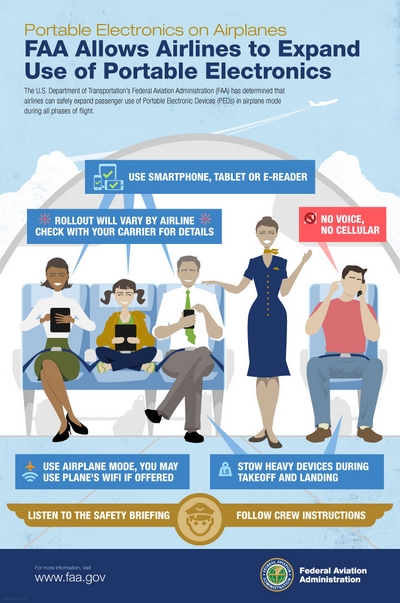
A flyer distributed by the Federal Aviation Administration, announcing to the public that the FAA will allow airlines to expand the use of portable electronics during flights.
The California Valley Miwok Tribe received notification from the USA.gov Team informing the Tribe that the Federal Aviation Administration (FAA) has given airlines the ability to expand the use of personal electronic devices (PED) for passengers on board. In short, that means, you could soon be able to listen to your music or read books on an e-reader from gate-to-gate on your flight. Individual airlines will have the ability to determine when it is safe for passengers to use their electronic devices.
According to the U.S. Department of Transportation Federal Aviation Administration (FAA), current FAA regulations require an aircraft operator to determine that radio frequency interference from PEDs are not a flight safety risk before the operator authorizes them for use during certain phases of flight. An airline must show it can prevent potential interference that could pose a safety hazard. On January 7, 2013, the Administrator of the FAA established the Portable Electronic Devices (PED) Aviation Rulemaking Committee (ARC) to provide a forum for the U.S. aviation community and government regulatory groups to review this PED policy and guidance. The ARC was tasked to make recommendations to further clarify and provide guidance on allowing additional PED usage without compromising the continued safe operation of the aircraft.
What is a PED? A PED is a Portable Electronic Device (PED) is any piece of lightweight, electronically-powered equipment. These devices are typically consumer electronic devices capable of communications, data processing and/or utility. Examples range from handheld, lightweight electronic devices such as tablets, e-readers, and smartphones to small devices such as MP3 players and electronic toys.
Due to differences among fleets and operations, the implementation will vary among airlines, but the agency expects many carriers will prove to the FAA that their planes allow passengers to safely use their devices in airplane mode, gate-to-gate, by the end of the year. The FAA based its decision on input from a group of experts that included representatives from the airlines, aviation manufacturers, passengers, pilots, flight attendants, and the mobile technology industry. Cell phones differ from PEDs in that they are designed to send out signals strong enough to be received at great distances. Cell phones may not be used for voice communications. The FAA is not considering the use of cell phones for voice communications during flight because Federal Communications Commission (FCC) regulations prohibit any airborne calls using cell phones.
Changes to PED policies will not happen immediately and will vary by airplane. Check with your airline to see if and when you can use your PED. Devices must be used in airplane mode or with the cellular connection disabled. You may use the WiFi connection on your device if the plane has an installed WiFi system and the airline allows its use. Properly stow heavier devices under seats or in the overhead bins during takeoff and landing. These items could impede evacuation of an aircraft or may injure you or someone else in the event of turbulence or an accident.
Always follow crew instructions and immediately turn off your device if asked.






